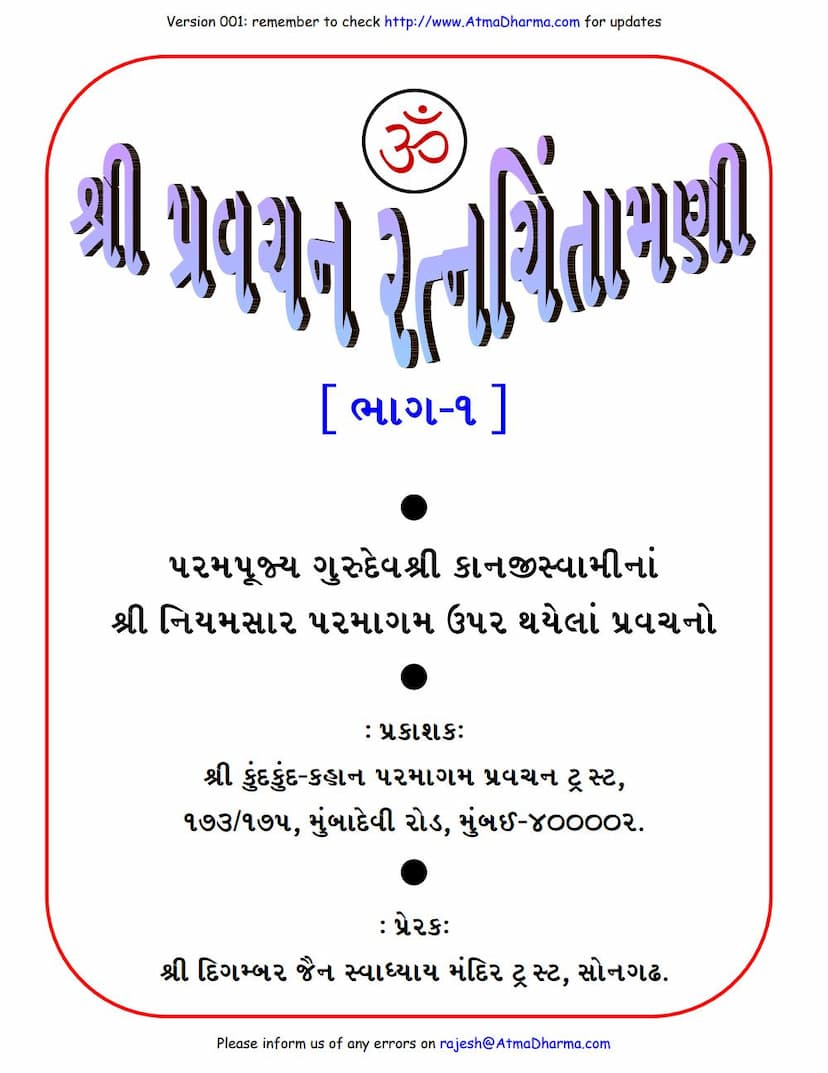Pravachana Ratna Chintamani 1
Added to library: September 2, 2025

Summary
This Jain text, "Pravachana Ratna Chintamani Book 1" by Kanjiswami, is a collection of discourses on the Jain scripture "Niyamsara" by Acharya Kundakunda. The book delves into profound spiritual concepts, focusing on the nature of the soul and the path to liberation. Here's a summary of its key aspects:
Core Subject Matter:
The text is primarily an exposition of Acharya Kundakunda's "Niyamsara," a foundational Jain scripture that explains the principles of conduct and the nature of reality according to Jain philosophy. Kanjiswami, through his discourses, aims to illuminate the deep spiritual insights within Niyamsara.
Key Themes and Concepts:
-
The Soul (Jiva): The text emphasizes the soul's true nature as pure, eternal, omniscient, and intrinsically blissful. It contrasts this true nature with the soul's current state, which is obscured by karmic particles and mistaken identity with the physical body and worldly experiences.
-
Karma: Jain philosophy's central concept of karma is intricately woven throughout. The discourses likely explain how karmic substances adhere to the soul due to actions driven by passions (kashayas) and how this karma binds the soul to the cycle of birth and death (samsara).
-
The Path to Liberation (Moksha): The ultimate goal discussed is liberation from samsara and the attainment of omniscience and eternal bliss. This path is presented as the practice of "Niyamsara" itself, which translates to the "Rule of Conduct" or "Essence of the Law." This path is centered around:
- Right Faith (Samyak Darshan): Understanding the true nature of reality, particularly the soul's self-existence and purity.
- Right Knowledge (Samyak Jnana): Knowing the soul's true nature and the nature of reality without attachment or aversion.
- Right Conduct (Samyak Charitra): Living in accordance with this understanding, which involves detachment from worldly pleasures and a focus on inner spiritual practices.
-
Niyamsara's Significance: The discourses highlight Niyamsara's importance, perhaps even suggesting it contains deeper or more subtle spiritual principles than other prominent works like Samaysara. The text likely emphasizes the Niyamsara's role in guiding the aspirant towards the true essence of the soul.
-
The Role of the Guru: The text acknowledges the profound influence of Kanjiswami as the Guru who elucidated these teachings. His discourses are presented as the means by which listeners can awaken their spiritual understanding and practice. The importance of a Guru in guiding the path is implicitly or explicitly conveyed.
-
Discrimination between Self and Non-Self (Naya Vada): A significant aspect of Jain philosophy, and likely of this text, is the discrimination between the soul (Self) and the non-soul (body, mind, senses, karma, etc.). The discourses would have likely stressed the importance of recognizing the soul's true nature, which is distinct from all non-soully elements.
-
The "Essence" or "Rule": The title "Niyamsara" itself points to the core message of the book: adhering to the true spiritual path, the essence of liberation. This would involve cultivating inner purity, detachment, and focusing on the soul's innate qualities.
Structure and Content:
Based on the provided page numbers and table of contents (Anukramanika), the text is structured as follows:
- Mangalacharan (Invocation): The book begins with auspicious invocations to the Siddhas, the Jinas, the Jain scriptures (Jin-vani), and the Guru, setting a spiritual tone.
- Pravachanas (Discourses): The core of the book consists of discourses by Kanjiswami on specific verses (Gathas/Shlokas) of the Niyamsara. The table of contents lists these discourses, indicating the date of the lecture and the relevant scripture reference (e.g., Shlok 1-7, Gatha-1).
- Thematic Progression: The discourses likely move through the Niyamsara chapter by chapter, elaborating on the philosophical and practical aspects of Jainism, with a strong emphasis on the soul's inherent purity and the path to realizing it.
- Commentary: The text is based on the "Tatparyavritti" (explanatory commentary) by Shri Padmaprabhamaladhari. Kanjiswami's discourses are essentially elaborations on this existing commentary.
Overall Tone and Purpose:
The text is written in Gujarati, reflecting its origin and target audience. The discourses of Pujya Gurudev Shri Kanji Swami are revered for their clarity and depth in explaining complex Jain philosophical concepts. The publisher, Kundkund Kahhan Paramagam Pravachan Trust, and the motivating body, Shri Digamber Jain Swadhyay Mandir Trust, Son Gadh, indicate a focus on the Digambara Jain tradition. The overall purpose is to guide sincere seekers (mumukshus) towards spiritual liberation by expounding the timeless wisdom of the Niyamsara.
In summary, "Pravachana Ratna Chintamani Book 1" is a spiritual guide presenting Kanjiswami's insightful discourses on the Niyamsara, offering a path to self-realization and liberation by focusing on the soul's true nature and the principles of right conduct, free from worldly attachments and impurities.